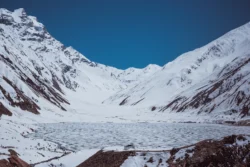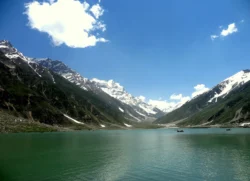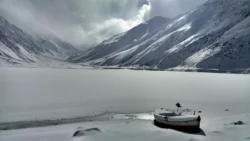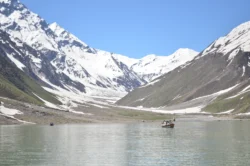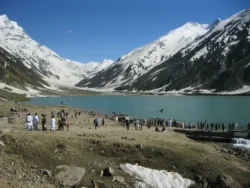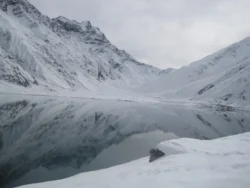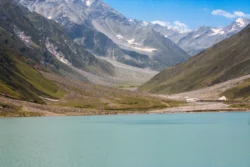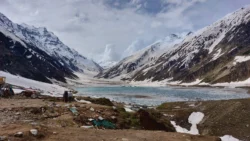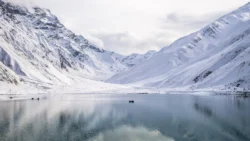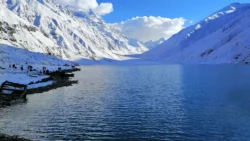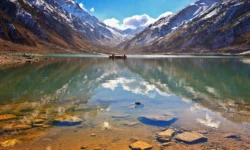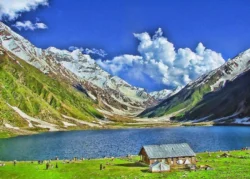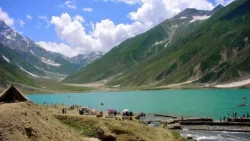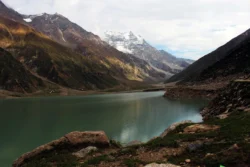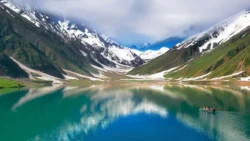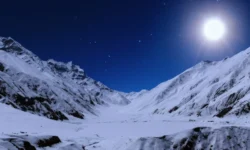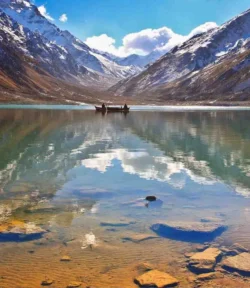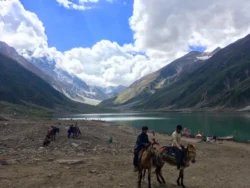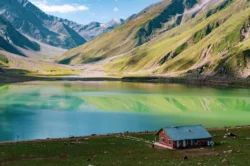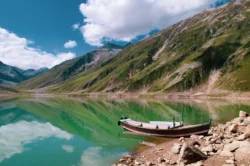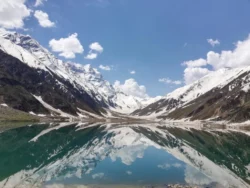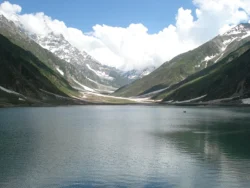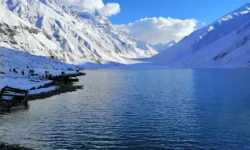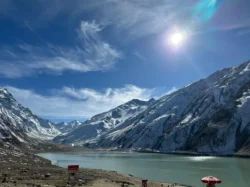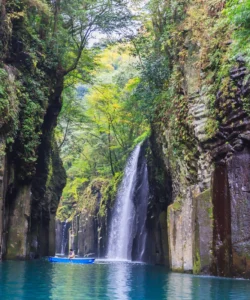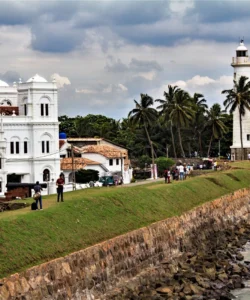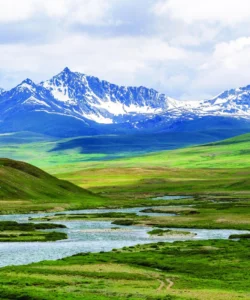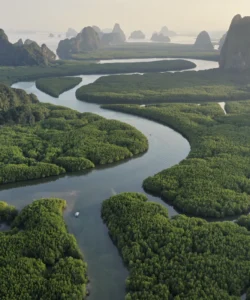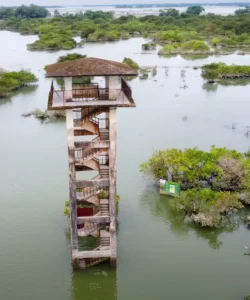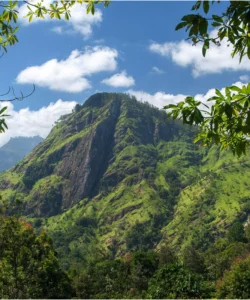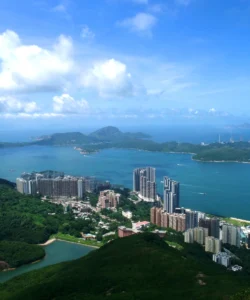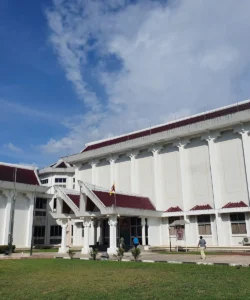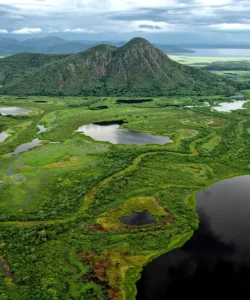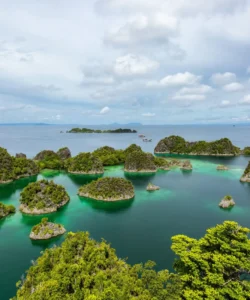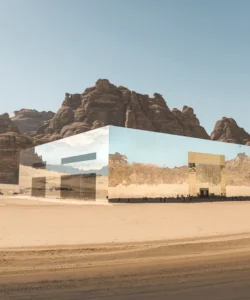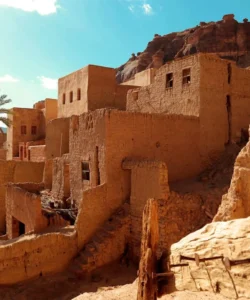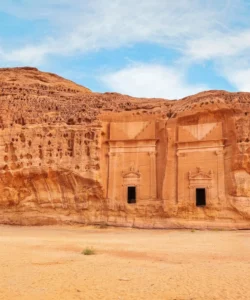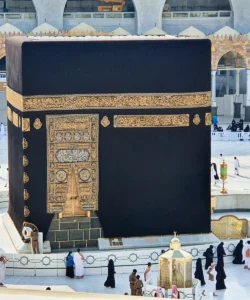It seems there might be a slight confusion in the spelling of the name. It’s likely you’re referring to Saif-ul-Muluk, a renowned lake in Pakistan. If so, here’s a detailed overview:
Saiful Muluk is a stunning alpine lake located in the Manoor Valley, Kaghan Valley, Khyber Pakhtunkhwa province, Pakistan. It is one of Pakistan’s most famous and enchanting natural wonders, renowned for its breathtaking beauty, pristine turquoise waters, and the captivating folklore associated with it.
Name: Saif-ul-Muluk (Urdu: جھیل سیف الملوک; also Saif ul Malook, Saif ul Malook Lake)
Address: Manoor Valley, Kaghan Valley, Mansehra District, Khyber Pakhtunkhwa Province, Pakistan. It is situated at the northern end of the Kaghan Valley, near the town of Naran.
How to Get There:
Access to Saif-ul-Muluk Lake is seasonal and requires a combination of road travel and often a challenging jeep ride.
- By Air: The closest major international airport is Islamabad International Airport (ISB). From Islamabad, you would travel by road to Mansehra, then Balakot, and onwards into the Kaghan Valley.
- By Road to Naran:
- From Islamabad/Rawalpindi: The most common route is to drive to Mansehra (approx. 4-5 hours), then Balakot (an additional 1 hour), and finally to Naran (approx. 3-4 hours from Balakot). The road is generally paved and in good condition up to Naran (Mansehra-Naran-Jalkhad-Chilas Road/N-15).
- This road (N-15) is only open from late May/early June to late October/early November, depending on snowfall. It is closed during winter.
- From Naran to Saif-ul-Muluk Lake:
- 4×4 Jeep (Mandatory): From Naran, the only way to reach Saif-ul-Muluk Lake is by hiring a 4×4 jeep. The track is extremely rough, rocky, and steep, taking approximately 45 minutes to 1 hour each way. It’s an adventurous and bumpy ride.
- Trekking: For the adventurous and fit, it’s possible to trek from Naran to the lake, which takes around 3-5 hours (uphill).
- Best Time to Visit: The lake is accessible only during the summer months, from June to September.
- June-July: Snow has largely melted, and wildflowers start to bloom. The lake is still very cold.
- August-September: The weather is generally more stable, and the surrounding meadows are lush green. This is considered the best time for clear views and camping.
- Permit/Fees: There is typically a nominal entry fee to the lake area.
Landscape and Architecture:
Saif-ul-Muluk’s “architecture” is entirely natural, a stunning display of a pristine alpine lake nestled amidst towering Himalayan peaks.
- Alpine Lake: Saif-ul-Muluk is a pristine alpine lake situated at an elevation of 3,224 meters (10,578 feet) above sea level. Its water is exceptionally clear, fed by glacial meltwater from the surrounding mountains, giving it a striking turquoise-blue to emerald-green color.
- Mount Malika Parbat: The lake is dramatically framed by the towering, snow-capped peak of Malika Parbat (Queen of Mountains), which rises to 5,290 meters (17,356 feet) and forms a majestic backdrop, its reflection often visible in the calm waters of the lake.
- Glaciers: Surrounding mountains feed small glaciers that contribute to the lake’s water. Remnants of snow and ice can often be seen on the mountain slopes even in summer.
- Lush Meadows and Forests: The immediate vicinity of the lake consists of lush green alpine meadows that burst with wildflowers during summer. Lower slopes leading up to the lake are covered in coniferous (pine, fir, spruce) forests.
- Rivers and Streams: Small streams and waterfalls cascade down the mountain slopes, feeding the lake. The Kunhar River originates from this lake, flowing down through the entire Kaghan Valley.
- No Permanent Human Architecture: There are no permanent human settlements or significant built structures directly at the lake. Any “architecture” is limited to very basic rest shelters or temporary tea stalls that operate during the tourist season, designed to be minimal and blend with the natural environment. Camping is popular around the lake.
- Fairytale-like Setting: The combination of the crystal-clear lake, snow-capped peaks, and lush meadows creates a magical, almost fairytale-like ambiance, especially in the early morning light.
What Makes It Famous:
- Breathtaking Natural Beauty: Saif-ul-Muluk is widely regarded as one of the most beautiful lakes in Pakistan and a jewel of the Kaghan Valley. Its pristine turquoise waters, framed by towering peaks and lush meadows, are renowned for their stunning scenic beauty.
- Legend of Prince Saif-ul-Muluk and Fairy Badi-ul-Jamal: The lake is intrinsically linked to a famous fairytale (folkloric qissa) from Persian mythology and local tradition. The legend tells of a Persian Prince Saif-ul-Muluk who fell in love with a fairy princess, Badi-ul-Jamal, whom he saw bathing in the lake, and their subsequent trials and reunion. This romantic and mystical tale adds a profound cultural dimension to its fame.
- Mount Malika Parbat: The iconic peak of Malika Parbat, towering over the lake, is a significant part of its famous panorama.
- High-Altitude Alpine Experience: Its location at over 3,200 meters provides a true high-altitude alpine experience, with crisp, clean air and the raw grandeur of the Himalaya.
- Trekking and Camping Destination: It’s a popular base for short treks to surrounding valleys (like Ansoo Lake, the teardrop-shaped lake) and a favored spot for camping under the stars.
- Accessible Adventure: While the jeep ride is challenging, the lake is relatively accessible to a wide range of visitors who are comfortable with the off-road journey, offering a taste of Himalayan adventure without requiring multi-day expeditions.
Differences from Some Other Wonders:
- Alpine Lake with Specific Folklore: While other lakes exist in the Himalaya (e.g., Pangong Tso, Sheosar Lake), Saif-ul-Muluk’s fame is deeply tied to its specific, widely known, romantic fairytale/folklore of Prince Saif-ul-Muluk and the fairy princess, which imbues the lake with a unique mystical aura not found in other purely geological or ecological lakes.
- Pristine & Cold Alpine Water: Its identity as a pristine, exceptionally clear, and cold alpine lake fed by glacial meltwater, contrasting with warmer or saline lakes (e.g., Lonar Lake, Loktak Lake), is a key characteristic.
- Access by Challenging Jeep Track: While some mountain sites require trekking, Saif-ul-Muluk’s primary access via a notoriously rough, single-lane 4×4 jeep track from Naran (often perceived as part of the adventure itself) is a distinctive logistical feature.
- No Permanent Structures/Villages at Site: Similar to Deosai Plains, there are no permanent villages or developed tourist infrastructure directly at the lake, emphasizing its raw, untouched natural beauty and reliance on camping or basic seasonal stalls.
- Part of a Larger Valley: While it’s a star attraction, it’s also nestled within the picturesque Kaghan Valley, which is a broader regional tourist destination known for its rivers, forests, and other natural sites.
- No Major Wildlife Focus: While it has local wildlife, the lake’s primary fame isn’t for specific “big game” or rare species (like the Himalayan Brown Bear of Deosai or the Komodo dragon). Its appeal is overwhelmingly scenic and folkloric.
Saif-ul-Muluk Photos:



